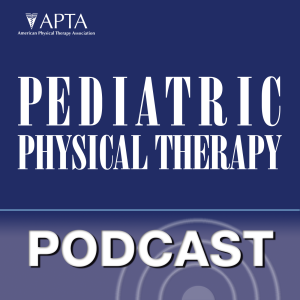
Concurrent Validity Between Live and Home-Video Observations Using the Alberta Infant Motor Scale Marike Boonzaaijer, Research Centre for Innovation in Healthcare, University of Applied Sciences, Utrecht, the NetherlandsThis paper explores the utility of home videos taken by parents for using the Alberta Infant Motor Scale to assess gross motor function compared to live observations.Hand Grip Strength: A Population-Based Study of Norms and Age Trajectories for 3- to 17-Year-OldsRichard Bohannon, Campbell University, Campbell, NCThis paper presents data from the National Institutes of Health (NIH) Toolbox project to provide normative values and equations for measuring and assessing grip strength in children.Position Between Trunk and Pelvis During Gait Related to the Gross Motor Function Classification System Jose Manuel Sanz-Mengibar, Balance Physio, Clapham, London,UKThis paper looks at the trunk positions in children with spastic cerebral palsy, specifically on how the trunk positions change between the Gross Motor Function Classification levels using 3-D kinematics. Gait Training with Visual Feedback and Proprioceptive Input to Reduce Gait Asymmetry in Adults with Cerebral Palsy: A Case SeriesIlana Levin, Human Movement Science Department, UNC Chapel Hill This paper examines on whether providing visual feedback about gait asymmetry in the form of virtual reality during gait retraining improves gait speed and dynamic balance in adults with cerebral palsy.Autogenic Drainage in Children With Cystic Fibrosis: System Lieselotte Corten, Grootte Schuur Hospital, Cape Town, South Africa This review investigates the effect of autogenic drainage and assisted autogenic drainage compared to no, sham, or other types of airway clearance in children with cystic fibrosis.Pediatric rehabilitation services for children with cerebral palsy: what can existing data sources tell us?Mary Gannotti, University of Hartford, West Hartford, ConnecticutThis is a summary of fourteen national, state, and local sources of data in the United States that provide information about children with cerebral palsy, their health, function, well being, and utilization of health services. Despite limitations, currently available sources of data may provide meaningful information for policy, practice, and program development.
view more
More Episodes
Volume 31, Issue 2, Part 2
 2019-03-27
2019-03-27
 2019-03-27
2019-03-27
Volume 31, Issue 2, Part 1
 2019-03-27
2019-03-27
 2019-03-27
2019-03-27
Volume 31, Issue 1
 2018-12-20
2018-12-20
 2018-12-20
2018-12-20
Volume 30, Issue 4
 2018-10-02
2018-10-02
 2018-10-02
2018-10-02
Volume 30, Issue 3
 2018-07-03
2018-07-03
 2018-07-03
2018-07-03
Volume 30, Issue 2
 2018-03-26
2018-03-26
 2018-03-26
2018-03-26
Volume 30, Issue 1
 2018-01-08
2018-01-08
 2018-01-08
2018-01-08
Volume 29, Issue 4
 2017-10-04
2017-10-04
 7
7
 2017-10-04
2017-10-04
 7
7
Volume 29, Issue 3
 2017-07-17
2017-07-17
 8
8
 2017-07-17
2017-07-17
 8
8
Volume 29, Issue 1
 2016-12-21
2016-12-21
 5
5
 2016-12-21
2016-12-21
 5
5
Volume 28, Issue 4, Winter
 2016-09-26
2016-09-26
 4
4
 2016-09-26
2016-09-26
 4
4
Volume 28, Issue 3, Fall
 2016-06-29
2016-06-29
 2
2
 2016-06-29
2016-06-29
 2
2
Volume 28, Issue 2, Summer
 2016-03-31
2016-03-31
 2016-03-31
2016-03-31
Volume 28, Issue 1, Spring
 2015-12-28
2015-12-28
 1
1
 2015-12-28
2015-12-28
 1
1
Volume 27, Issue 4, Winter
 2015-10-02
2015-10-02
 2015-10-02
2015-10-02
Volume 27, Issue 3, Fall
 2015-06-24
2015-06-24
 2015-06-24
2015-06-24
Volume 27, Issue 2, Summer
 2015-04-07
2015-04-07
 2015-04-07
2015-04-07
Volume 27, Issue 1, Spring
 2015-01-06
2015-01-06
 2015-01-06
2015-01-06
Volume 26, Issue 4, Winter
 2014-10-16
2014-10-16
 2014-10-16
2014-10-16
01234567810111213141516171819
Create your
podcast in
minutes
- Full-featured podcast site
- Unlimited storage and bandwidth
- Comprehensive podcast stats
- Distribute to Apple Podcasts, Spotify, and more
- Make money with your podcast
It is Free
- Privacy Policy
- Cookie Policy
- Terms of Use
- Consent Preferences
- Copyright © 2015-2024 Podbean.com





